University Nursing Assignment: Salbutamol Delivery in Pediatric Asthma
VerifiedAdded on 2023/03/20
|12
|1740
|73
Report
AI Summary
This nursing assignment addresses the clinical scenario of a 10-year-old child admitted to the emergency department with an exacerbation of asthma secondary to bronchitis, who has been prescribed Salbutamol. The paper investigates the most appropriate method of Salbutamol delivery: nebulizer or spacer. The student conducted a literature review using databases like Google Scholar and CINHAL, formulating a research question and employing specific inclusion and exclusion criteria, along with relevant keywords. The analysis draws on several research papers, including those by DiBlasi (2015), Kwok and Chan (2014), and Cates, Welsh, and Rowe (2013), comparing the effectiveness of the two delivery methods in terms of clinical outcomes, ease of use, and economic feasibility. The assignment concludes that nebulizers are more effective for chronic asthma, but spacers can be effective in mild to moderate cases and are more cost-effective, with the choice dependent on patient response and resource availability.
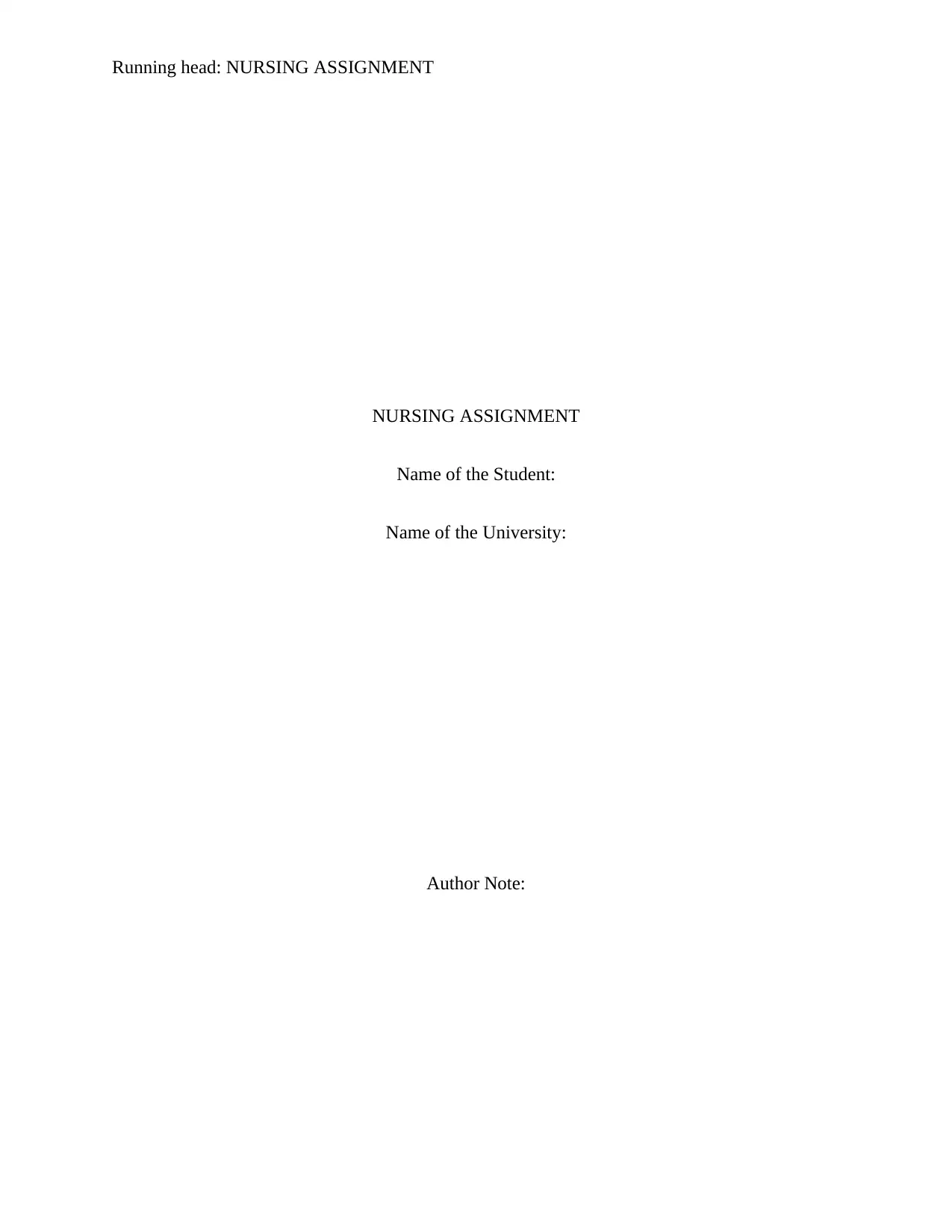
Running head: NURSING ASSIGNMENT
NURSING ASSIGNMENT
Name of the Student:
Name of the University:
Author Note:
NURSING ASSIGNMENT
Name of the Student:
Name of the University:
Author Note:
Paraphrase This Document
Need a fresh take? Get an instant paraphrase of this document with our AI Paraphraser
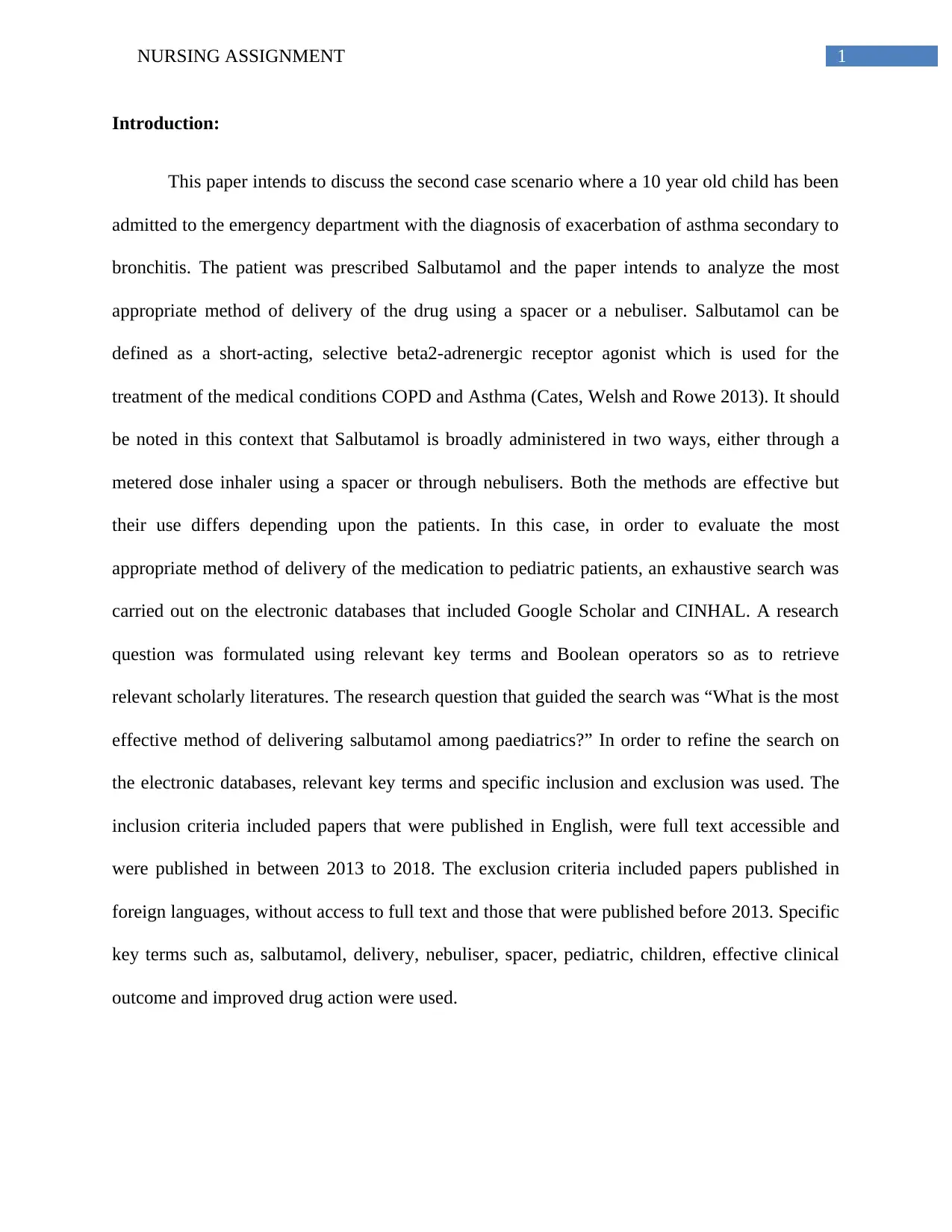
1NURSING ASSIGNMENT
Introduction:
This paper intends to discuss the second case scenario where a 10 year old child has been
admitted to the emergency department with the diagnosis of exacerbation of asthma secondary to
bronchitis. The patient was prescribed Salbutamol and the paper intends to analyze the most
appropriate method of delivery of the drug using a spacer or a nebuliser. Salbutamol can be
defined as a short-acting, selective beta2-adrenergic receptor agonist which is used for the
treatment of the medical conditions COPD and Asthma (Cates, Welsh and Rowe 2013). It should
be noted in this context that Salbutamol is broadly administered in two ways, either through a
metered dose inhaler using a spacer or through nebulisers. Both the methods are effective but
their use differs depending upon the patients. In this case, in order to evaluate the most
appropriate method of delivery of the medication to pediatric patients, an exhaustive search was
carried out on the electronic databases that included Google Scholar and CINHAL. A research
question was formulated using relevant key terms and Boolean operators so as to retrieve
relevant scholarly literatures. The research question that guided the search was “What is the most
effective method of delivering salbutamol among paediatrics?” In order to refine the search on
the electronic databases, relevant key terms and specific inclusion and exclusion was used. The
inclusion criteria included papers that were published in English, were full text accessible and
were published in between 2013 to 2018. The exclusion criteria included papers published in
foreign languages, without access to full text and those that were published before 2013. Specific
key terms such as, salbutamol, delivery, nebuliser, spacer, pediatric, children, effective clinical
outcome and improved drug action were used.
Introduction:
This paper intends to discuss the second case scenario where a 10 year old child has been
admitted to the emergency department with the diagnosis of exacerbation of asthma secondary to
bronchitis. The patient was prescribed Salbutamol and the paper intends to analyze the most
appropriate method of delivery of the drug using a spacer or a nebuliser. Salbutamol can be
defined as a short-acting, selective beta2-adrenergic receptor agonist which is used for the
treatment of the medical conditions COPD and Asthma (Cates, Welsh and Rowe 2013). It should
be noted in this context that Salbutamol is broadly administered in two ways, either through a
metered dose inhaler using a spacer or through nebulisers. Both the methods are effective but
their use differs depending upon the patients. In this case, in order to evaluate the most
appropriate method of delivery of the medication to pediatric patients, an exhaustive search was
carried out on the electronic databases that included Google Scholar and CINHAL. A research
question was formulated using relevant key terms and Boolean operators so as to retrieve
relevant scholarly literatures. The research question that guided the search was “What is the most
effective method of delivering salbutamol among paediatrics?” In order to refine the search on
the electronic databases, relevant key terms and specific inclusion and exclusion was used. The
inclusion criteria included papers that were published in English, were full text accessible and
were published in between 2013 to 2018. The exclusion criteria included papers published in
foreign languages, without access to full text and those that were published before 2013. Specific
key terms such as, salbutamol, delivery, nebuliser, spacer, pediatric, children, effective clinical
outcome and improved drug action were used.
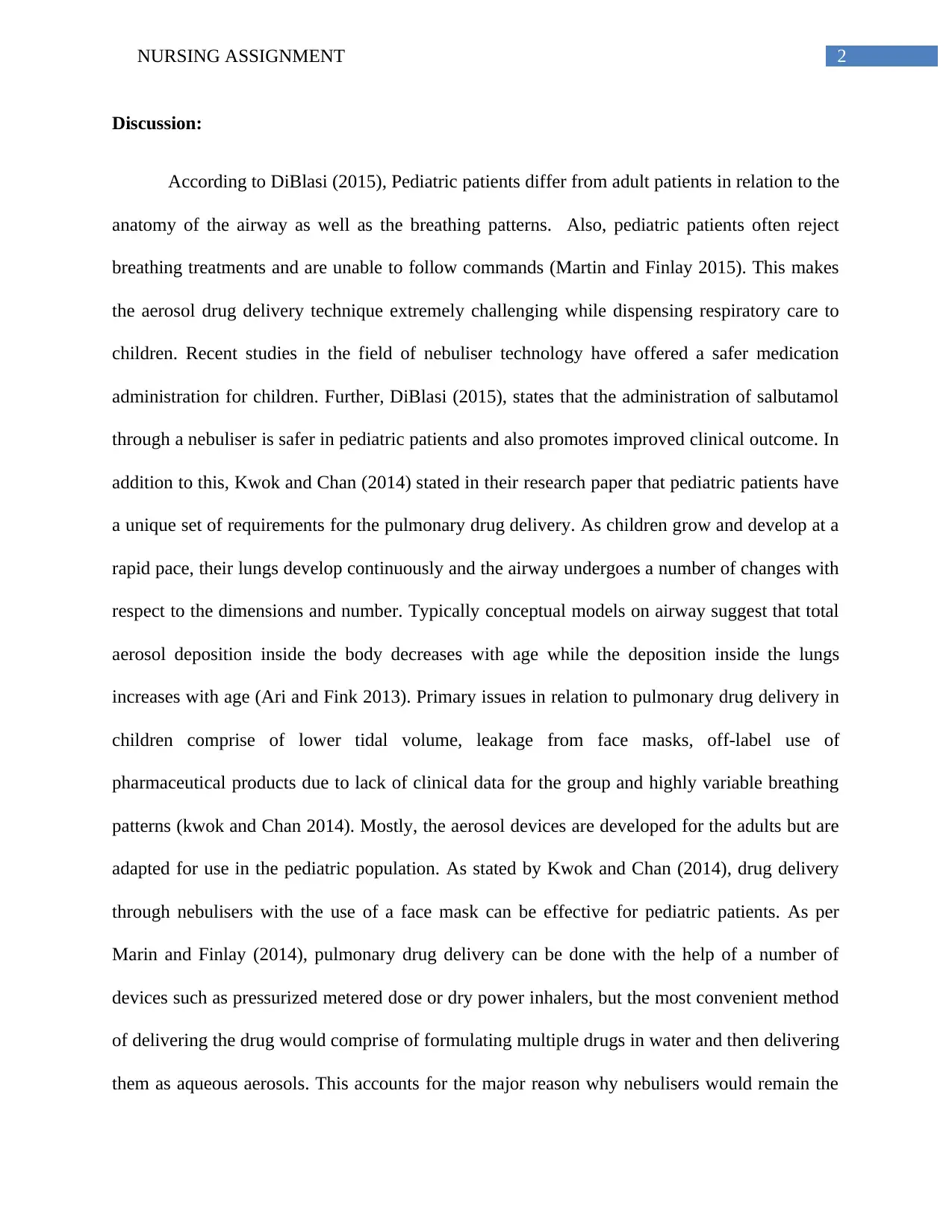
2NURSING ASSIGNMENT
Discussion:
According to DiBlasi (2015), Pediatric patients differ from adult patients in relation to the
anatomy of the airway as well as the breathing patterns. Also, pediatric patients often reject
breathing treatments and are unable to follow commands (Martin and Finlay 2015). This makes
the aerosol drug delivery technique extremely challenging while dispensing respiratory care to
children. Recent studies in the field of nebuliser technology have offered a safer medication
administration for children. Further, DiBlasi (2015), states that the administration of salbutamol
through a nebuliser is safer in pediatric patients and also promotes improved clinical outcome. In
addition to this, Kwok and Chan (2014) stated in their research paper that pediatric patients have
a unique set of requirements for the pulmonary drug delivery. As children grow and develop at a
rapid pace, their lungs develop continuously and the airway undergoes a number of changes with
respect to the dimensions and number. Typically conceptual models on airway suggest that total
aerosol deposition inside the body decreases with age while the deposition inside the lungs
increases with age (Ari and Fink 2013). Primary issues in relation to pulmonary drug delivery in
children comprise of lower tidal volume, leakage from face masks, off-label use of
pharmaceutical products due to lack of clinical data for the group and highly variable breathing
patterns (kwok and Chan 2014). Mostly, the aerosol devices are developed for the adults but are
adapted for use in the pediatric population. As stated by Kwok and Chan (2014), drug delivery
through nebulisers with the use of a face mask can be effective for pediatric patients. As per
Marin and Finlay (2014), pulmonary drug delivery can be done with the help of a number of
devices such as pressurized metered dose or dry power inhalers, but the most convenient method
of delivering the drug would comprise of formulating multiple drugs in water and then delivering
them as aqueous aerosols. This accounts for the major reason why nebulisers would remain the
Discussion:
According to DiBlasi (2015), Pediatric patients differ from adult patients in relation to the
anatomy of the airway as well as the breathing patterns. Also, pediatric patients often reject
breathing treatments and are unable to follow commands (Martin and Finlay 2015). This makes
the aerosol drug delivery technique extremely challenging while dispensing respiratory care to
children. Recent studies in the field of nebuliser technology have offered a safer medication
administration for children. Further, DiBlasi (2015), states that the administration of salbutamol
through a nebuliser is safer in pediatric patients and also promotes improved clinical outcome. In
addition to this, Kwok and Chan (2014) stated in their research paper that pediatric patients have
a unique set of requirements for the pulmonary drug delivery. As children grow and develop at a
rapid pace, their lungs develop continuously and the airway undergoes a number of changes with
respect to the dimensions and number. Typically conceptual models on airway suggest that total
aerosol deposition inside the body decreases with age while the deposition inside the lungs
increases with age (Ari and Fink 2013). Primary issues in relation to pulmonary drug delivery in
children comprise of lower tidal volume, leakage from face masks, off-label use of
pharmaceutical products due to lack of clinical data for the group and highly variable breathing
patterns (kwok and Chan 2014). Mostly, the aerosol devices are developed for the adults but are
adapted for use in the pediatric population. As stated by Kwok and Chan (2014), drug delivery
through nebulisers with the use of a face mask can be effective for pediatric patients. As per
Marin and Finlay (2014), pulmonary drug delivery can be done with the help of a number of
devices such as pressurized metered dose or dry power inhalers, but the most convenient method
of delivering the drug would comprise of formulating multiple drugs in water and then delivering
them as aqueous aerosols. This accounts for the major reason why nebulisers would remain the
⊘ This is a preview!⊘
Do you want full access?
Subscribe today to unlock all pages.

Trusted by 1+ million students worldwide
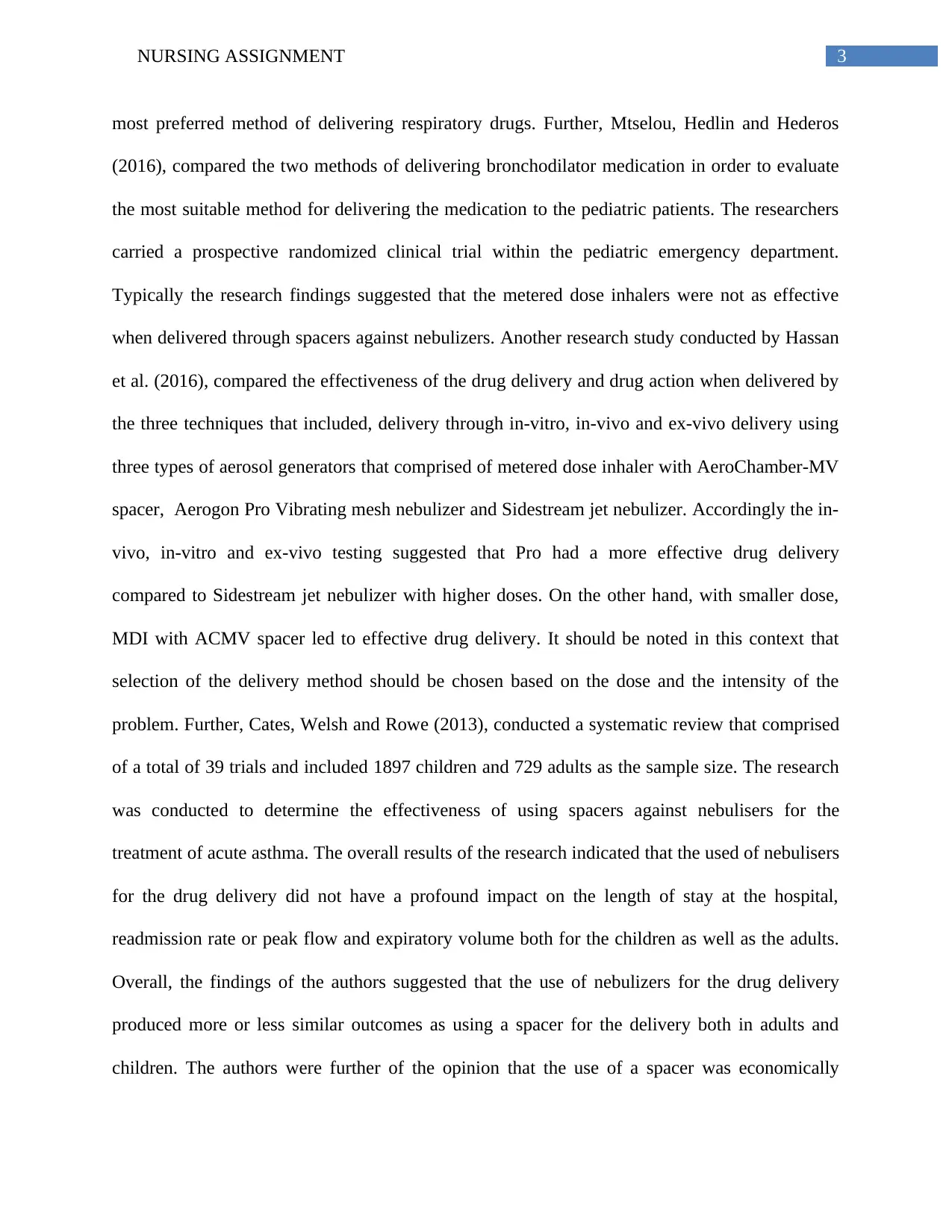
3NURSING ASSIGNMENT
most preferred method of delivering respiratory drugs. Further, Mtselou, Hedlin and Hederos
(2016), compared the two methods of delivering bronchodilator medication in order to evaluate
the most suitable method for delivering the medication to the pediatric patients. The researchers
carried a prospective randomized clinical trial within the pediatric emergency department.
Typically the research findings suggested that the metered dose inhalers were not as effective
when delivered through spacers against nebulizers. Another research study conducted by Hassan
et al. (2016), compared the effectiveness of the drug delivery and drug action when delivered by
the three techniques that included, delivery through in-vitro, in-vivo and ex-vivo delivery using
three types of aerosol generators that comprised of metered dose inhaler with AeroChamber-MV
spacer, Aerogon Pro Vibrating mesh nebulizer and Sidestream jet nebulizer. Accordingly the in-
vivo, in-vitro and ex-vivo testing suggested that Pro had a more effective drug delivery
compared to Sidestream jet nebulizer with higher doses. On the other hand, with smaller dose,
MDI with ACMV spacer led to effective drug delivery. It should be noted in this context that
selection of the delivery method should be chosen based on the dose and the intensity of the
problem. Further, Cates, Welsh and Rowe (2013), conducted a systematic review that comprised
of a total of 39 trials and included 1897 children and 729 adults as the sample size. The research
was conducted to determine the effectiveness of using spacers against nebulisers for the
treatment of acute asthma. The overall results of the research indicated that the used of nebulisers
for the drug delivery did not have a profound impact on the length of stay at the hospital,
readmission rate or peak flow and expiratory volume both for the children as well as the adults.
Overall, the findings of the authors suggested that the use of nebulizers for the drug delivery
produced more or less similar outcomes as using a spacer for the delivery both in adults and
children. The authors were further of the opinion that the use of a spacer was economically
most preferred method of delivering respiratory drugs. Further, Mtselou, Hedlin and Hederos
(2016), compared the two methods of delivering bronchodilator medication in order to evaluate
the most suitable method for delivering the medication to the pediatric patients. The researchers
carried a prospective randomized clinical trial within the pediatric emergency department.
Typically the research findings suggested that the metered dose inhalers were not as effective
when delivered through spacers against nebulizers. Another research study conducted by Hassan
et al. (2016), compared the effectiveness of the drug delivery and drug action when delivered by
the three techniques that included, delivery through in-vitro, in-vivo and ex-vivo delivery using
three types of aerosol generators that comprised of metered dose inhaler with AeroChamber-MV
spacer, Aerogon Pro Vibrating mesh nebulizer and Sidestream jet nebulizer. Accordingly the in-
vivo, in-vitro and ex-vivo testing suggested that Pro had a more effective drug delivery
compared to Sidestream jet nebulizer with higher doses. On the other hand, with smaller dose,
MDI with ACMV spacer led to effective drug delivery. It should be noted in this context that
selection of the delivery method should be chosen based on the dose and the intensity of the
problem. Further, Cates, Welsh and Rowe (2013), conducted a systematic review that comprised
of a total of 39 trials and included 1897 children and 729 adults as the sample size. The research
was conducted to determine the effectiveness of using spacers against nebulisers for the
treatment of acute asthma. The overall results of the research indicated that the used of nebulisers
for the drug delivery did not have a profound impact on the length of stay at the hospital,
readmission rate or peak flow and expiratory volume both for the children as well as the adults.
Overall, the findings of the authors suggested that the use of nebulizers for the drug delivery
produced more or less similar outcomes as using a spacer for the delivery both in adults and
children. The authors were further of the opinion that the use of a spacer was economically
Paraphrase This Document
Need a fresh take? Get an instant paraphrase of this document with our AI Paraphraser
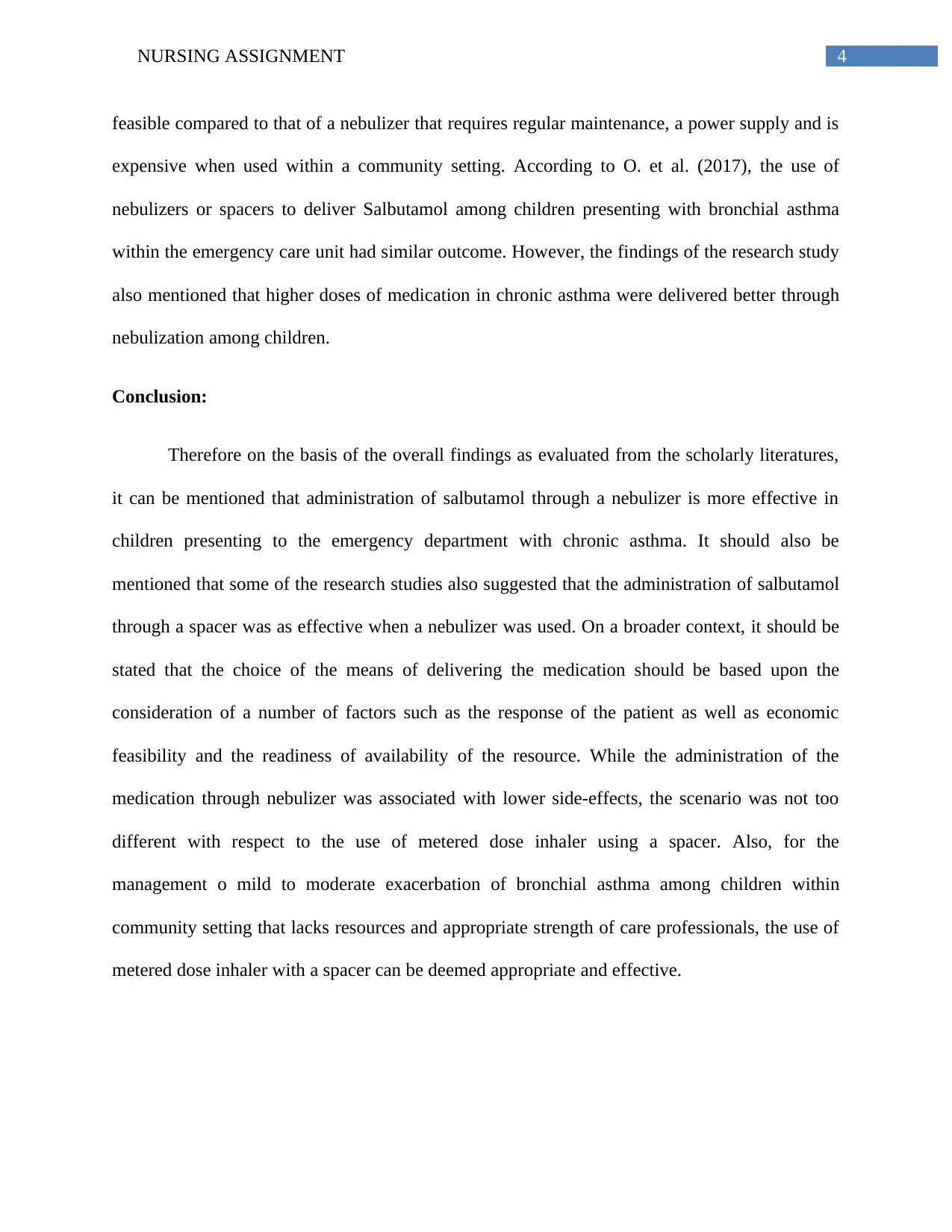
4NURSING ASSIGNMENT
feasible compared to that of a nebulizer that requires regular maintenance, a power supply and is
expensive when used within a community setting. According to O. et al. (2017), the use of
nebulizers or spacers to deliver Salbutamol among children presenting with bronchial asthma
within the emergency care unit had similar outcome. However, the findings of the research study
also mentioned that higher doses of medication in chronic asthma were delivered better through
nebulization among children.
Conclusion:
Therefore on the basis of the overall findings as evaluated from the scholarly literatures,
it can be mentioned that administration of salbutamol through a nebulizer is more effective in
children presenting to the emergency department with chronic asthma. It should also be
mentioned that some of the research studies also suggested that the administration of salbutamol
through a spacer was as effective when a nebulizer was used. On a broader context, it should be
stated that the choice of the means of delivering the medication should be based upon the
consideration of a number of factors such as the response of the patient as well as economic
feasibility and the readiness of availability of the resource. While the administration of the
medication through nebulizer was associated with lower side-effects, the scenario was not too
different with respect to the use of metered dose inhaler using a spacer. Also, for the
management o mild to moderate exacerbation of bronchial asthma among children within
community setting that lacks resources and appropriate strength of care professionals, the use of
metered dose inhaler with a spacer can be deemed appropriate and effective.
feasible compared to that of a nebulizer that requires regular maintenance, a power supply and is
expensive when used within a community setting. According to O. et al. (2017), the use of
nebulizers or spacers to deliver Salbutamol among children presenting with bronchial asthma
within the emergency care unit had similar outcome. However, the findings of the research study
also mentioned that higher doses of medication in chronic asthma were delivered better through
nebulization among children.
Conclusion:
Therefore on the basis of the overall findings as evaluated from the scholarly literatures,
it can be mentioned that administration of salbutamol through a nebulizer is more effective in
children presenting to the emergency department with chronic asthma. It should also be
mentioned that some of the research studies also suggested that the administration of salbutamol
through a spacer was as effective when a nebulizer was used. On a broader context, it should be
stated that the choice of the means of delivering the medication should be based upon the
consideration of a number of factors such as the response of the patient as well as economic
feasibility and the readiness of availability of the resource. While the administration of the
medication through nebulizer was associated with lower side-effects, the scenario was not too
different with respect to the use of metered dose inhaler using a spacer. Also, for the
management o mild to moderate exacerbation of bronchial asthma among children within
community setting that lacks resources and appropriate strength of care professionals, the use of
metered dose inhaler with a spacer can be deemed appropriate and effective.
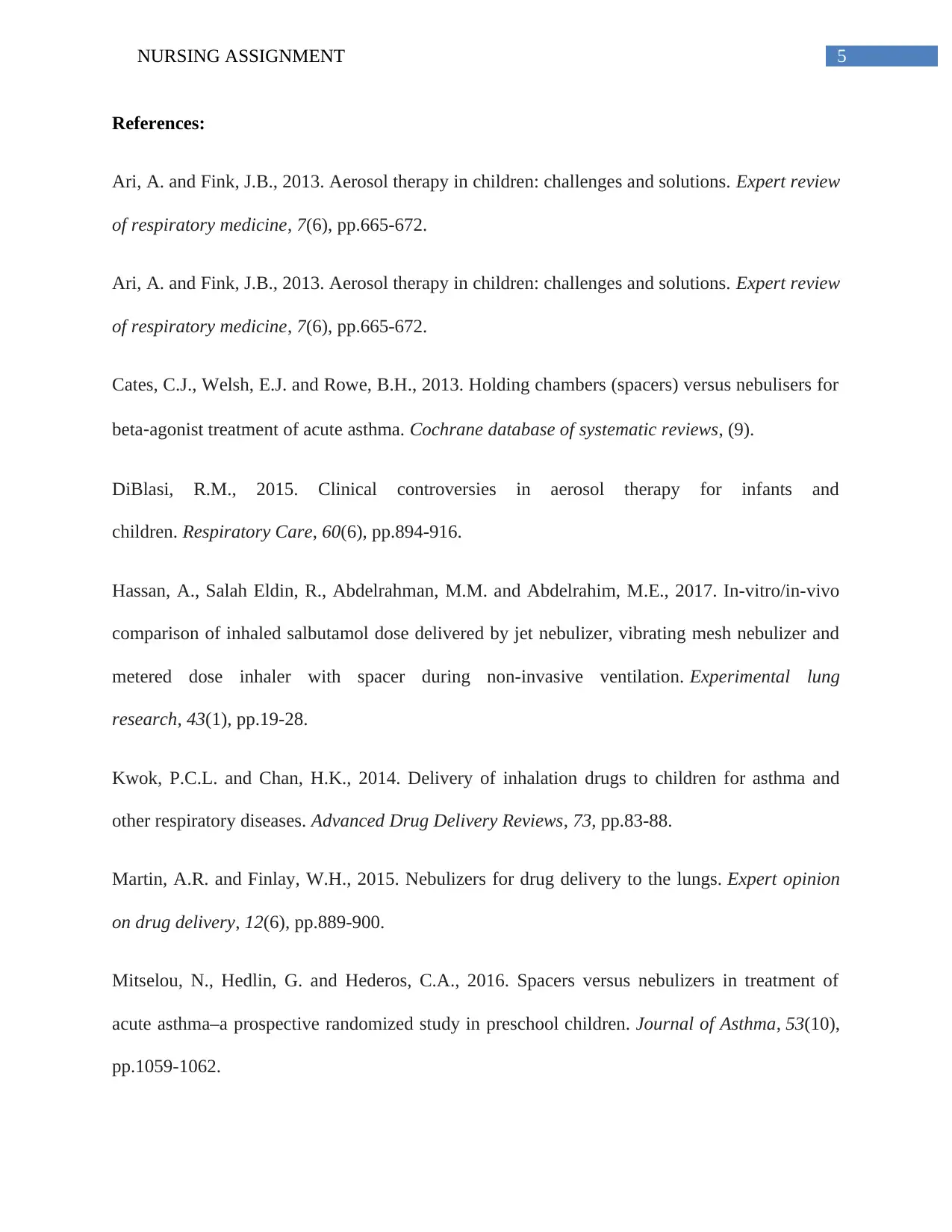
5NURSING ASSIGNMENT
References:
Ari, A. and Fink, J.B., 2013. Aerosol therapy in children: challenges and solutions. Expert review
of respiratory medicine, 7(6), pp.665-672.
Ari, A. and Fink, J.B., 2013. Aerosol therapy in children: challenges and solutions. Expert review
of respiratory medicine, 7(6), pp.665-672.
Cates, C.J., Welsh, E.J. and Rowe, B.H., 2013. Holding chambers (spacers) versus nebulisers for
beta‐agonist treatment of acute asthma. Cochrane database of systematic reviews, (9).
DiBlasi, R.M., 2015. Clinical controversies in aerosol therapy for infants and
children. Respiratory Care, 60(6), pp.894-916.
Hassan, A., Salah Eldin, R., Abdelrahman, M.M. and Abdelrahim, M.E., 2017. In-vitro/in-vivo
comparison of inhaled salbutamol dose delivered by jet nebulizer, vibrating mesh nebulizer and
metered dose inhaler with spacer during non-invasive ventilation. Experimental lung
research, 43(1), pp.19-28.
Kwok, P.C.L. and Chan, H.K., 2014. Delivery of inhalation drugs to children for asthma and
other respiratory diseases. Advanced Drug Delivery Reviews, 73, pp.83-88.
Martin, A.R. and Finlay, W.H., 2015. Nebulizers for drug delivery to the lungs. Expert opinion
on drug delivery, 12(6), pp.889-900.
Mitselou, N., Hedlin, G. and Hederos, C.A., 2016. Spacers versus nebulizers in treatment of
acute asthma–a prospective randomized study in preschool children. Journal of Asthma, 53(10),
pp.1059-1062.
References:
Ari, A. and Fink, J.B., 2013. Aerosol therapy in children: challenges and solutions. Expert review
of respiratory medicine, 7(6), pp.665-672.
Ari, A. and Fink, J.B., 2013. Aerosol therapy in children: challenges and solutions. Expert review
of respiratory medicine, 7(6), pp.665-672.
Cates, C.J., Welsh, E.J. and Rowe, B.H., 2013. Holding chambers (spacers) versus nebulisers for
beta‐agonist treatment of acute asthma. Cochrane database of systematic reviews, (9).
DiBlasi, R.M., 2015. Clinical controversies in aerosol therapy for infants and
children. Respiratory Care, 60(6), pp.894-916.
Hassan, A., Salah Eldin, R., Abdelrahman, M.M. and Abdelrahim, M.E., 2017. In-vitro/in-vivo
comparison of inhaled salbutamol dose delivered by jet nebulizer, vibrating mesh nebulizer and
metered dose inhaler with spacer during non-invasive ventilation. Experimental lung
research, 43(1), pp.19-28.
Kwok, P.C.L. and Chan, H.K., 2014. Delivery of inhalation drugs to children for asthma and
other respiratory diseases. Advanced Drug Delivery Reviews, 73, pp.83-88.
Martin, A.R. and Finlay, W.H., 2015. Nebulizers for drug delivery to the lungs. Expert opinion
on drug delivery, 12(6), pp.889-900.
Mitselou, N., Hedlin, G. and Hederos, C.A., 2016. Spacers versus nebulizers in treatment of
acute asthma–a prospective randomized study in preschool children. Journal of Asthma, 53(10),
pp.1059-1062.
⊘ This is a preview!⊘
Do you want full access?
Subscribe today to unlock all pages.

Trusted by 1+ million students worldwide

6NURSING ASSIGNMENT
O, J., Daniel, S. and Krishnan, M. 2019. Comparison of clinical efficacy of nebulised salbutamol
and salbutamol metered dose inhaler in children with mild or moderate exacerbation of
bronchial asthma. [online] Available at:
http://www.ijpediatrics.com/index.php/ijcp/article/download/730/619 [Accessed 12 May 2019].
O, J., Daniel, S. and Krishnan, M. 2019. Comparison of clinical efficacy of nebulised salbutamol
and salbutamol metered dose inhaler in children with mild or moderate exacerbation of
bronchial asthma. [online] Available at:
http://www.ijpediatrics.com/index.php/ijcp/article/download/730/619 [Accessed 12 May 2019].
Paraphrase This Document
Need a fresh take? Get an instant paraphrase of this document with our AI Paraphraser
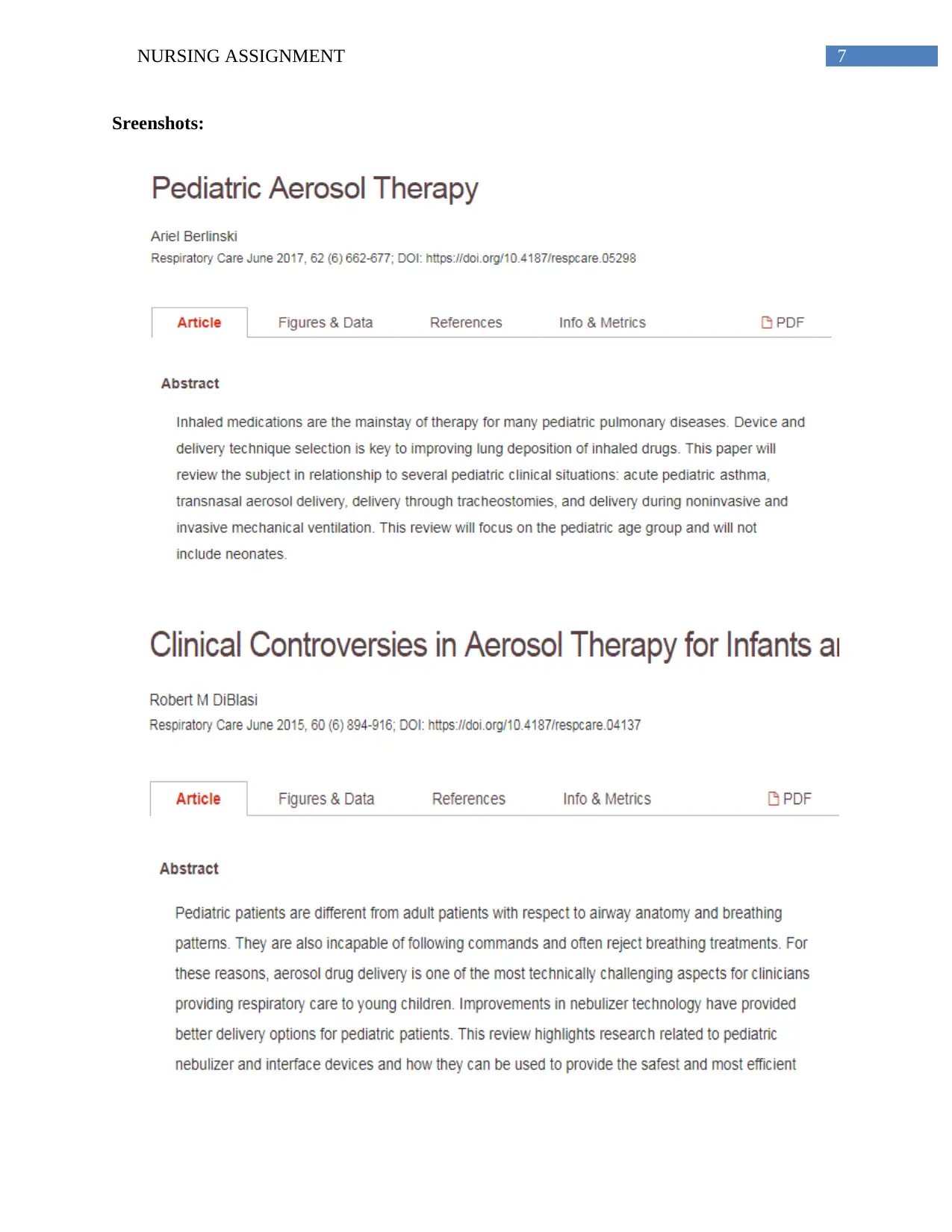
7NURSING ASSIGNMENT
Sreenshots:
Sreenshots:
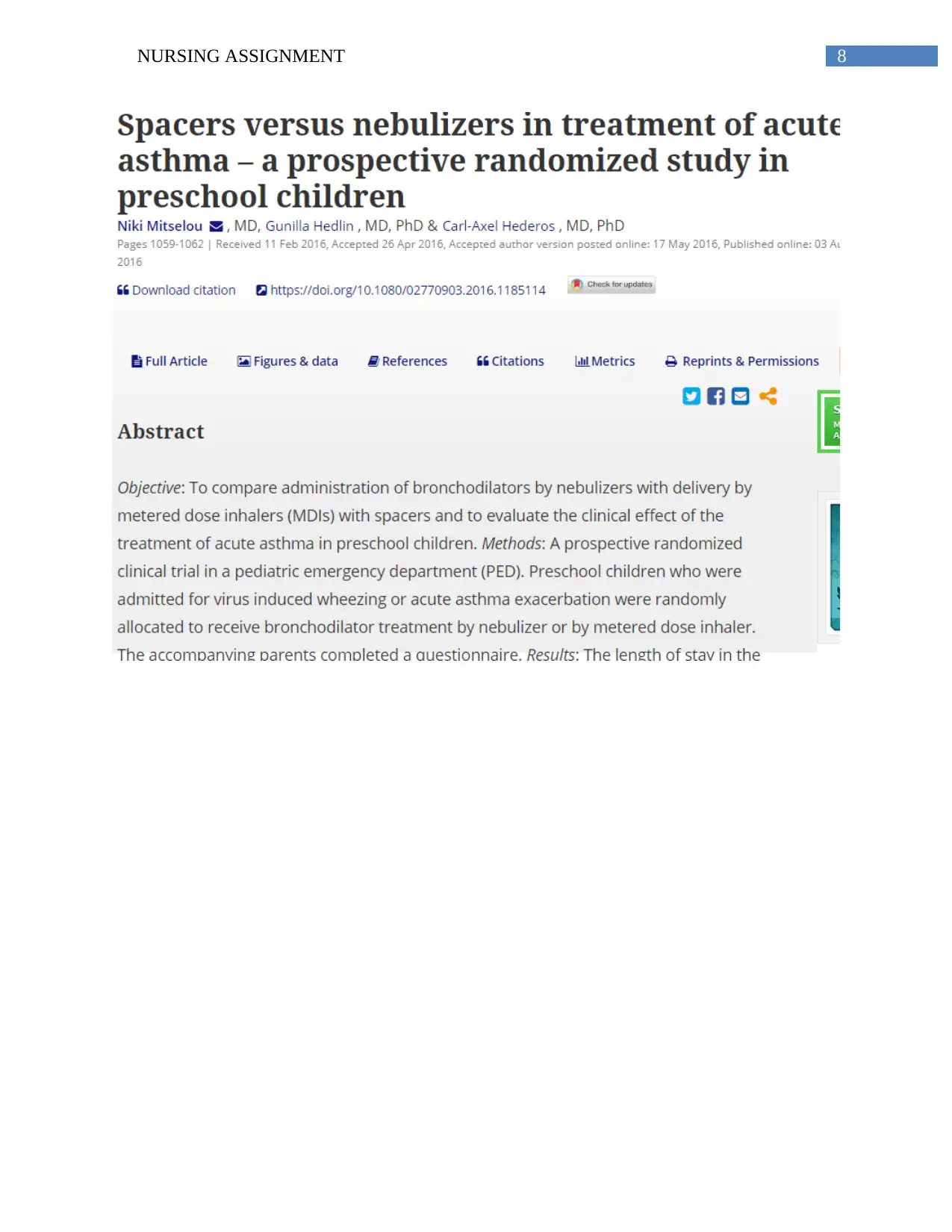
8NURSING ASSIGNMENT
⊘ This is a preview!⊘
Do you want full access?
Subscribe today to unlock all pages.

Trusted by 1+ million students worldwide
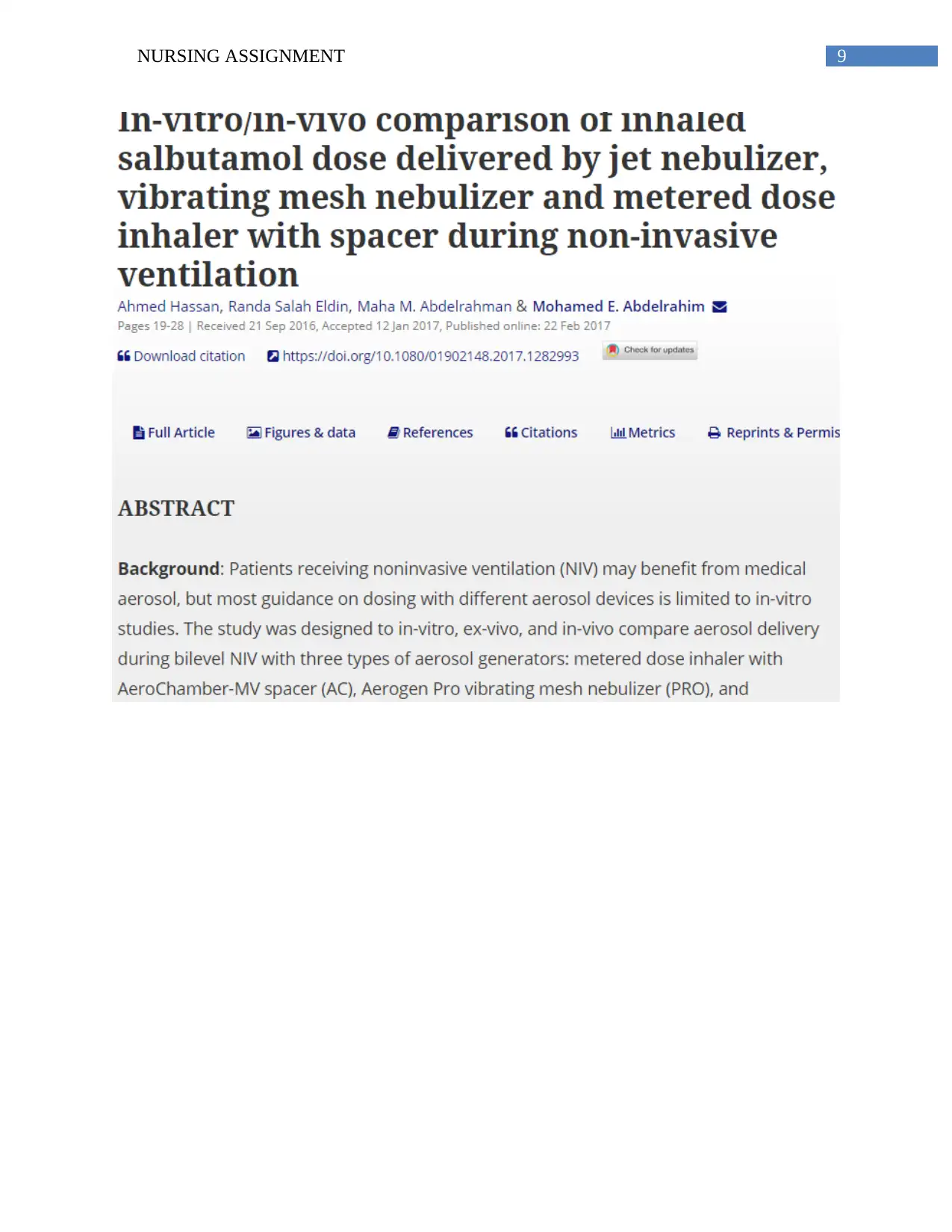
9NURSING ASSIGNMENT
Paraphrase This Document
Need a fresh take? Get an instant paraphrase of this document with our AI Paraphraser
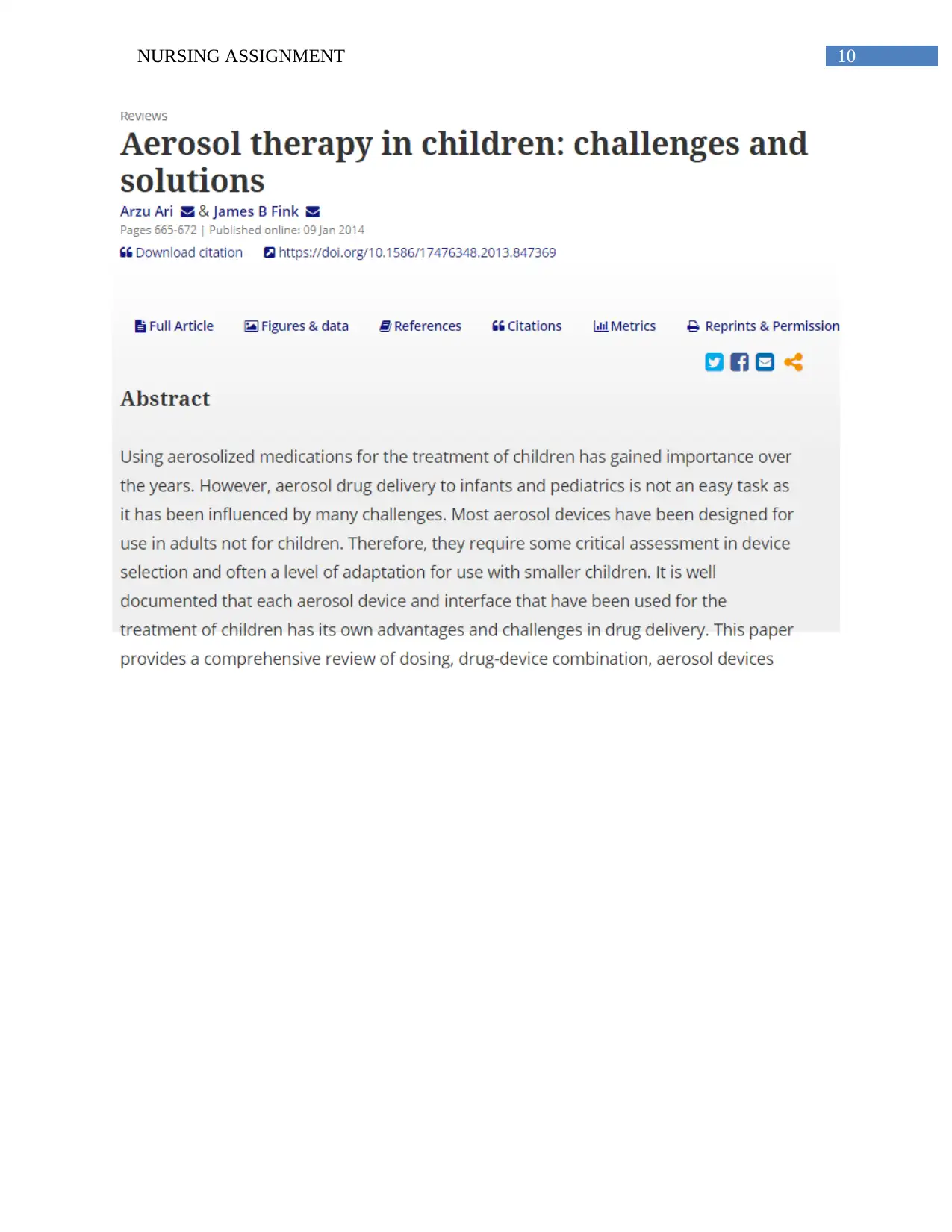
10NURSING ASSIGNMENT
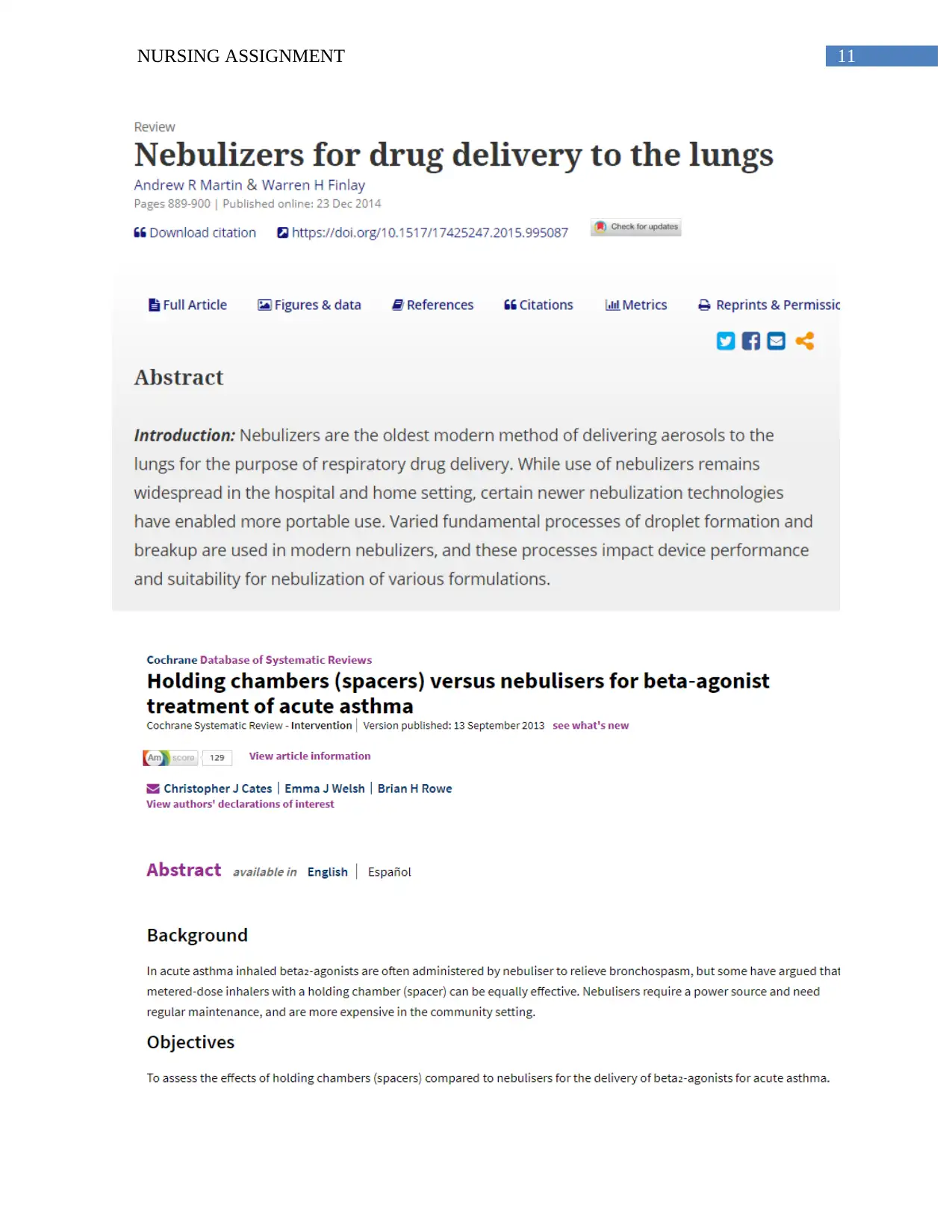
11NURSING ASSIGNMENT
⊘ This is a preview!⊘
Do you want full access?
Subscribe today to unlock all pages.

Trusted by 1+ million students worldwide
1 out of 12
Related Documents
Your All-in-One AI-Powered Toolkit for Academic Success.
+13062052269
info@desklib.com
Available 24*7 on WhatsApp / Email
![[object Object]](/_next/static/media/star-bottom.7253800d.svg)
Unlock your academic potential
Copyright © 2020–2025 A2Z Services. All Rights Reserved. Developed and managed by ZUCOL.





